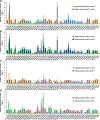Novel Polymerase Gene Mutations for Human Adaptation in Clinical Isolates of Avian H5N1 Influenza Viruses
- PMID: 27097026
- PMCID: PMC4838241
- DOI: 10.1371/journal.ppat.1005583
Novel Polymerase Gene Mutations for Human Adaptation in Clinical Isolates of Avian H5N1 Influenza Viruses
Abstract
A major determinant in the change of the avian influenza virus host range to humans is the E627K substitution in the PB2 polymerase protein. However, the polymerase activity of avian influenza viruses with a single PB2-E627K mutation is still lower than that of seasonal human influenza viruses, implying that avian viruses require polymerase mutations in addition to PB2-627K for human adaptation. Here, we used a database search of H5N1 clade 2.2.1 virus sequences with the PB2-627K mutation to identify other polymerase adaptation mutations that have been selected in infected patients. Several of the mutations identified acted cooperatively with PB2-627K to increase viral growth in human airway epithelial cells and mouse lungs. These mutations were in multiple domains of the polymerase complex other than the PB2-627 domain, highlighting a complicated avian-to-human adaptation pathway of avian influenza viruses. Thus, H5N1 viruses could rapidly acquire multiple polymerase mutations that function cooperatively with PB2-627K in infected patients for optimal human adaptation.
Conflict of interest statement
The authors have declared that no competing interests exist.
Figures







References
Publication types
MeSH terms
Substances
LinkOut - more resources
Full Text Sources
Other Literature Sources
Medical
Research Materials

